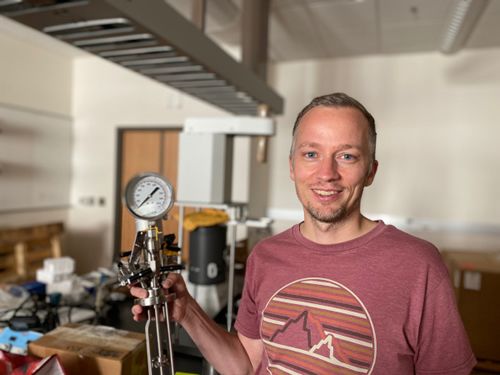
Ore Deposits & Critical Minerals Research Laboratory
Lab Manager: Dr. Alex Gysi

The Ore Deposits and Critical Minerals experimental laboratory (ODCM Lab) was established in the NMBGMR in the fall of 2020 and is equipped to conduct hydrothermal fluid-rock experiments to study the stability of minerals and speciation of metals relevant to ore-forming processes at high temperatures and pressures. The goal of the ODCM Lab is to improve our understanding how critical elements are transported, fractionated and concentrated in the Earth’s crust and ultimately feed our geochemical models to predict fluid-rock interaction in a variety of geologic settings. The data generated from the ODCM Lab are provided via our open access MINES Thermodynamic Database, which is an internally consistent thermodynamic database. The most recent release is MINES23 (summer, 2023).
Research Capabilities
The ODCM Lab is currently supported by NSF and DOE grants with a focus on the properties of rare earth elements (REE) in hydrothermal aqueous fluids with MS and PhD students and Postdocs conducting research, and we also routinely train undergraduate students. We aim to provide the most up to date and accurate thermodynamic database for modeling hydrothermal ore-forming processes by integrating a wide array of experimental and thermodynamic optimization techniques. Our current expertise spans the following areas of research and hydrothermal experiment types described in more detail below:
- Mineral solubility and fluid-mineral partitioning experiments
- Hydrothermal solution calorimetry
- High temperature pH electrodes
- In situ UV-Vis/Raman spectroscopic measurements
- Hydrothermal diamond anvil cell (HDAC)
Mineral solubility and fluid-mineral partitioning experiments
Mineral solubility experiments are conducted in batch-type stainless steel Teflon-lined Parr acid digestion high pressure vessels. The REE partitioning experiments are conducted by precipitating REE-bearing minerals during fluid-mixing using a combination of stirred Parr reactors and HPLC pumps. The ODCM Lab is currently equipped with 12 Teflon-lined batch-type reactors, one 600 ml stirred Ti Parr reactor, two 100 ml stirred Hastelloy Parr reactors, two HPCL pumps, and 3 muffle furnaces. These devices are principally used to measure the partitioning of rare earth elements between aqueous fluids and calcite, fluorite, and apatite, and for measuring the solubility of REE phosphates (monazite, xenotime) and hydroxides.

Hydrothermal solution calorimetry

Measurements of enthalpy (heat) released or consumed during mineral precipitation/dissolution reactions are conducted in a solution calorimeter. These experiments are used to determine the enthalpy of mineral solid solutions (monazite and xenotime, rhabdophane) and aqueous REE species. The ODCM Lab is currently equipped with two different types of calorimeters including a a) Calvet-Tian type Setaram C80 hydrothermal solutions calorimeter with Hastelloy reaction cells that can be operated between 25 and 300°C and “rocked” to open a cell and initiate a reaction at elevated temperature, and b) a Parr 6755 solution calorimeter equipped with a Parr 6772 high-precision thermometer, which can be operated at room temperature.
High temperature potentiometric measurements
Potentiometric measurements permit determining pH in an aqueous solution and are commonly used to determine speciation in acidic to alkaline solutions. The ODCM Lab has a brand new set up of a 1 liter Hastelloy stirred Parr reactor equipped with Zr/Zr oxide electrodes and Ag/AgCl reference electrodes for in situ pH measurements between 95 and 300 °C. We use this setup to measure the solubility of REE hydroxides and determine the thermodynamic properties and speciation stoichiometry of REE hydroxyl complexes. This setup is pretty unique and custom designed in the ODCM Lab, which permits also titrating acids/bases during an experiment to vary pH and to sample the aqueous solution for further chemical analysis.

In situ spectroscopic measurements (UV-Vis and Raman)
We are developing new high temperature cells including batch-type capillary quartz cells and flow-through sapphire window systems to conduct in situ UV-Vis and Raman measurements. The ODCM Lab is currently equipped with an Agilent Cary 5000 dual beam spectrophotometer and Peltier temperature quartz cells to measure the speciation of REE to 75°C. We are in the process of developing a new flow-through sapphire window cell to conduct experiments between 250 to 400°C. We also making use of the new Raman laser funded through a NSF-MRI (Raman Lab) and developed a quartz capillary heating stage to conduct experiments between 25 and 250°C. These in situ spectroscopic measurements can be done at temperature and pressure. The measured spectra in the aqueous solutions vary depending on how the REE are bonding with different ligands. Currently we are focusing on REE hydroxyl, chloride, sulfate and carbonate complexes and developing new methods to identify REE aqueous species in hydrothermal fluids.

Hydrothermal diamond anvil cell (HDAC)
A hydrothermal diamond anvil cell consists of two diamonds and a gasket pressed together like two pistons. The cullet side of the diamonds have a smaller surface area and applying a pressure of ~40 bar in the gas membrane can easily result in pressures of more than 2 GPa (20 kbar). The ODCM Lab is equipped with a new Almax easyLab uScopeDAC-HT(G) Plus cell that can be operated to a temperature up to 600°C and is used to measure in situ the properties of REE and aqueous fluids in supercritical fluids.



